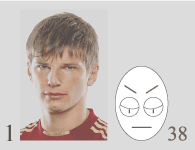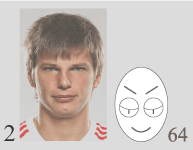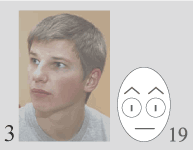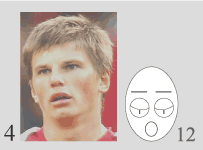-
Emotional images in faces of people are shown differently, as emotional types
predetermine possible movements of a mimicry and influence primary display of
those or other emotions. For instance, if to emotional type of a person there
correspond sad emotions of eyebrows then display of joyful emotions can be not
appreciable in emotional images because eyebrows as a result of mimic movements
cannot look like joyful emotions, but however the person possesses joyful
emotional displays irrespective of mimic movements which are possible according
to formal parameters of facial features.
Therefore during physiognomic identification of emotional types and emotional
images it is necessary to consider mobility and immovability of facial features,
and in essence it is necessary to distinguish formal modifications of emotional
images and observable modifications which cannot be seen according to movements
of a mimicry, but can be identified according to impressions which specify sad
either joyful, or other kinds of emotions.
For example, photos of football player Andrey Arshavin.
 |
The first photo corresponds to 26th physiognomic symbol
as outlines of eyebrows at temples are located above outlines at nose
bridge that corresponds with joyful emotions. Contours of eyelids at
temples are located above contours at nose bridge as if eyes are
slightly opened that corresponds to joyful emotions. The line of the
mouth is straight that corresponds to quiet emotions. According to the left eyebrow it is possible to identify quiet emotions, but according to the right eyebrow it is possible to see that emotions of eyebrows are joyful. |
 |
The second photo corresponds to 64th physiognomic
symbol as outlines of eyebrows at temples are above outlines at nose
bridge that corresponds with joyful emotions. Contours of eyelids at
temples are above contours at nose bridge that corresponds to joyful
emotions. Corners of the mouth are raised that corresponds to joyful
emotions. Joyful emotions of the mouth in this photo look deliberate. |
 |
The third photo corresponds to 19th physiognomic symbol
as outlines of eyebrows are raised and curved that corresponds to the
open emotions. Eyes seem widely opened that corresponds to the open
emotions. The line of the mouth is straight that corresponds to quiet
emotions. |
 |
The fourth photo corresponds to 12th physiognomic
symbol as outlines of eyebrows are straight that corresponds to quiet
emotions. Eyes express joyful emotions. Lips are slightly opened that
corresponds to the open emotions of the mouth. |
 |
The fifth photo corresponds to 53rd physiognomic symbol as outlines of eyebrows are straight that corresponds to quiet emotions. Eyes express sad emotions. The mouth is opened that corresponds to the open emotions. |
-
According to the shown movements of a mimicry it is possible to assume that
the emotional type of football player Andrey Arshavin corresponds to the first
photo and 38th physiognomic symbol, as quiet emotions of a mouth and also joyful
emotions of eyes and eyebrows look the most natural in comparison with other
emotions.
Feature of emotional displays in the face of Andrey Arshavin are identical
formal parameters of eyes at displays of joyful or sad emotions that is possible
to see in the fourth and fifth photos. Namely in both cases contours of eyelids
are identical, but however can be seen that expressions of eyes in the fourth
photo correspond to joyful emotions, and emotional expressions of eyes are sad
in the fifth photo.
It is caused by proportions of this face and proportions of eyes, that is
necessary to consider during identification of emotional types and images of
people when emotional displays are not shown in movements of a mimicry, or mimic
displays of emotional reactions are insignificant.
Thus it is necessary to mean that own emotions of the observer can influence
results of identification. For example, if emotions of the observer are sad then
there can be an impression that emotions of the observable person too are sad,
or if emotions of the observer are joyful then can seem that emotions of the
observable person too are joyful. But however is necessary to identify emotional
type and then possible to identify possible displays of emotional images
concerning emotions which are connected with features in emotional type. Becaus
as a result of displays of changeable emotional images it is possible to see
tension of mimic muscles or it is possible to see unnaturalness of emotions, or
it is possible to see other physiognomic attributes according to which it is
possible to distinguish constant formal parameters of emotional type from
changeable attributes of emotional images.
The following page shows methods of identification of emotional types by means of astrological calculations.
-